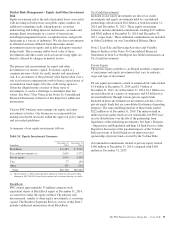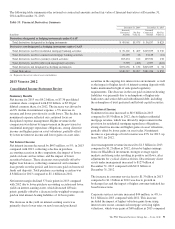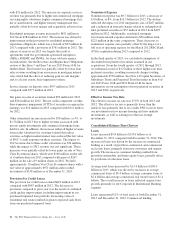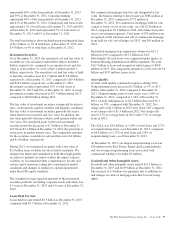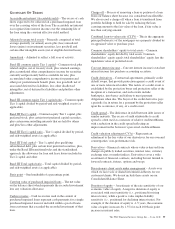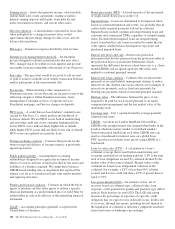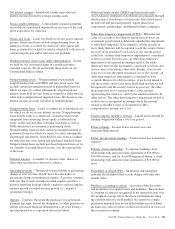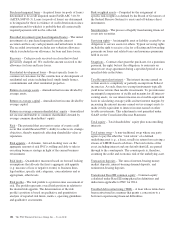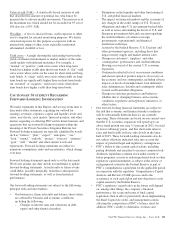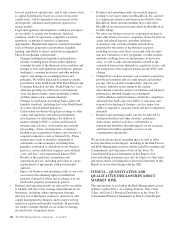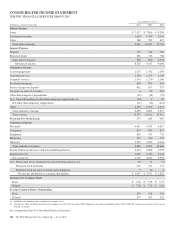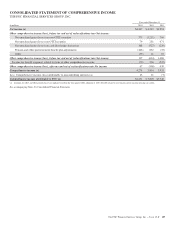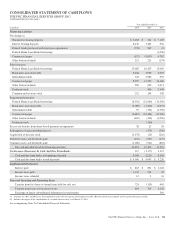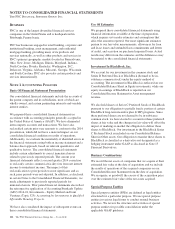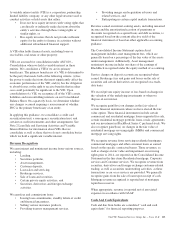PNC Bank 2014 Annual Report Download - page 121
Download and view the complete annual report
Please find page 121 of the 2014 PNC Bank annual report below. You can navigate through the pages in the report by either clicking on the pages listed below, or by using the keyword search tool below to find specific information within the annual report.
Value-at-risk (VaR) – A statistically-based measure of risk
that describes the amount of potential loss which may be
incurred due to adverse market movements. The measure is of
the maximum loss which should not be exceeded on 95 out of
100 days for a 95% VaR.
Watchlist – A list of criticized loans, credit exposure or other
assets compiled for internal monitoring purposes. We define
criticized exposure for this purpose as exposure with an
internal risk rating of other assets especially mentioned,
substandard, doubtful or loss.
Yield curve – A graph showing the relationship between the
yields on financial instruments or market indices of the same
credit quality with different maturities. For example, a
“normal” or “positive” yield curve exists when long-term
bonds have higher yields than short-term bonds. A “flat” yield
curve exists when yields are the same for short-term and long-
term bonds. A “steep” yield curve exists when yields on long-
term bonds are significantly higher than on short-term bonds.
An “inverted” or “negative” yield curve exists when short-
term bonds have higher yields than long-term bonds.
C
AUTIONARY
S
TATEMENT
R
EGARDING
F
ORWARD
-L
OOKING
I
NFORMATION
We make statements in this Report, and we may from time to
time make other statements, regarding our outlook for
earnings, revenues, expenses, capital and liquidity levels and
ratios, asset levels, asset quality, financial position, and other
matters regarding or affecting PNC and its future business and
operations that are forward-looking statements within the
meaning of the Private Securities Litigation Reform Act.
Forward-looking statements are typically identified by words
such as “believe,” “plan,” “expect,” “anticipate,” “see,”
“look,” “intend,” “outlook,” “project,” “forecast,” “estimate,”
“goal,” “will,” “should” and other similar words and
expressions. Forward-looking statements are subject to
numerous assumptions, risks and uncertainties, which change
over time.
Forward-looking statements speak only as of the date made.
We do not assume any duty and do not undertake to update
forward-looking statements. Actual results or future events
could differ, possibly materially, from those anticipated in
forward-looking statements, as well as from historical
performance.
Our forward-looking statements are subject to the following
principal risks and uncertainties.
• Our businesses, financial results and balance sheet values
are affected by business and economic conditions,
including the following:
– Changes in interest rates and valuations in debt,
equity and other financial markets.
– Disruptions in the liquidity and other functioning of
U.S. and global financial markets.
– The impact on financial markets and the economy of
any changes in the credit ratings of U.S. Treasury
obligations and other U.S. government-backed debt,
as well as issues surrounding the levels of U.S. and
European government debt and concerns regarding
the creditworthiness of certain sovereign
governments, supranationals and financial
institutions in Europe.
– Actions by the Federal Reserve, U.S. Treasury and
other government agencies, including those that
impact money supply and market interest rates.
– Changes in customers’, suppliers’ and other
counterparties’ performance and creditworthiness.
– Slowing or reversal of the current U.S. economic
expansion.
– Continued residual effects of recessionary conditions
and uneven spread of positive impacts of recovery on
the economy and our counterparties, including adverse
impacts on levels of unemployment, loan utilization
rates, delinquencies, defaults and counterparty ability
to meet credit and other obligations.
– Changes in customer preferences and behavior,
whether due to changing business and economic
conditions, legislative and regulatory initiatives, or
other factors.
• Our forward-looking financial statements are subject to
the risk that economic and financial market conditions
will be substantially different than we are currently
expecting. These statements are based on our current view
that the U.S. economic expansion will speed up to an
above trend growth rate near 3.5 percent in 2015, boosted
by lower oil/energy prices, and that short-term interest
rates and bond yields will rise only slowly in the latter
half of 2015. These forward-looking statements also do
not, unless otherwise indicated, take into account the
impact of potential legal and regulatory contingencies.
• PNC’s ability to take certain capital actions, including
paying dividends and any plans to increase common stock
dividends, repurchase common stock under current or
future programs, or issue or redeem preferred stock or other
regulatory capital instruments, is subject to the review of
such proposed actions by the Federal Reserve as part of
PNC’s comprehensive capital plan for the applicable period
in connection with the regulators’ Comprehensive Capital
Analysis and Review (CCAR) process and to the
acceptance of such capital plan and non-objection to such
capital actions by the Federal Reserve.
• PNC’s regulatory capital ratios in the future will depend
on, among other things, the company’s financial
performance, the scope and terms of final capital
regulations then in effect (particularly those implementing
the Basel Capital Accords), and management actions
affecting the composition of PNC’s balance sheet. In
addition, PNC’s ability to determine, evaluate and
The PNC Financial Services Group, Inc. – Form 10-K 103


